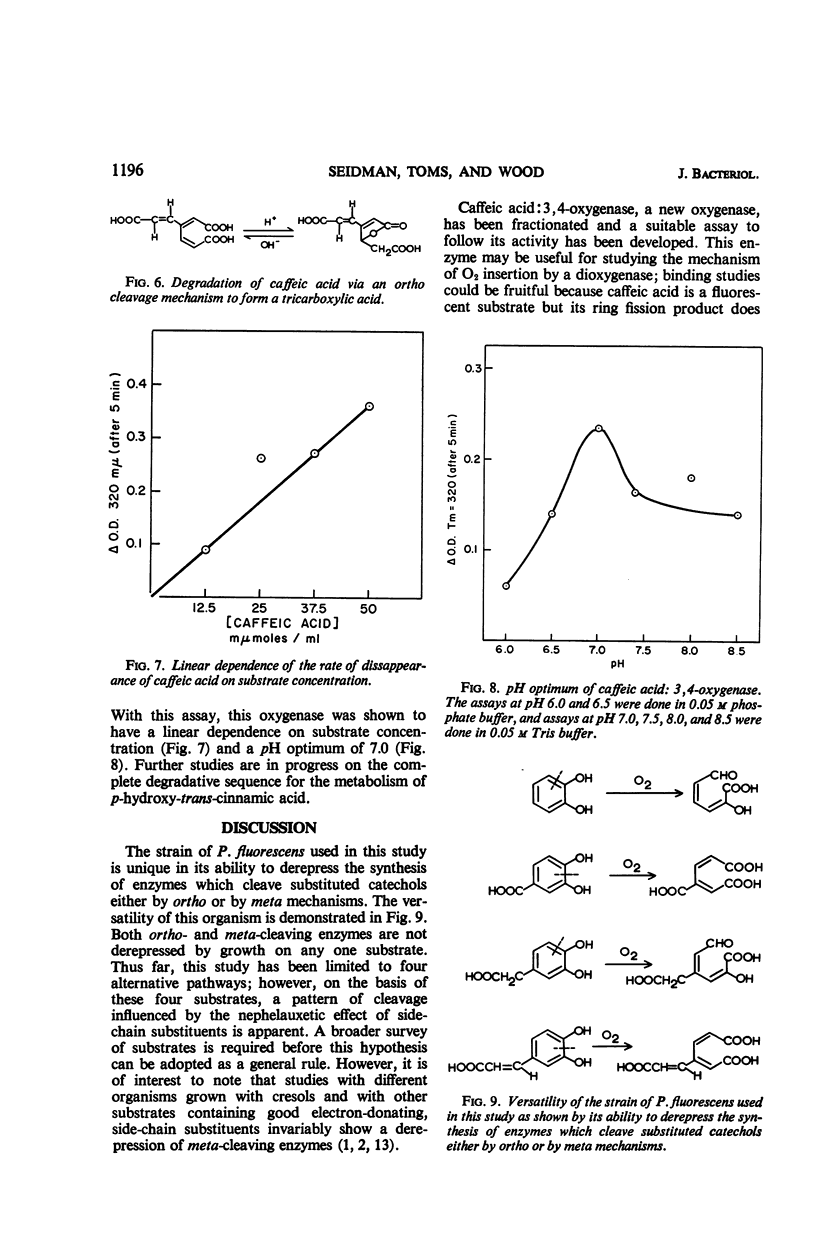Abstract
Pseudomonas fluorescens was grown on mineral salts media with phenol, p-hydroxybenzoic acid, p-hydroxy-phenylacetic acid, or p-hydroxy-trans-cinnamic acid as sole carbon and energy source. Each compound was first hydroxylated, ortho to the hydroxyl group on the benzene ring, to give catechol, protocatechuic acid (3,4-dihydroxy-benzoic acid), homoprotocatechuic acid (3,4-dihydroxy-phenylacetic acid), and caffeic acid (3,4-dihydroxy-trans-cinnamic acid), respectively, as the ultimate aromatic products before cleavage of the benzene nucleus. Protocatechuic acid and caffeic acid were shown to be cleaved by ortho fission, via a 3,4-oxygenase mechanism, to give β-substituted cis, cis-muconic acids as the initial aliphatic products. However, catechol and homoprotocatechuic acid were cleaved by meta fission, by 2,3-and 4,5-oxygenases, respectively, to give α-hydroxy-muconic semialdehyde and α-hydroxy-γ-carboxymethyl muconic semialdehyde as initial aliphatic intermediates. Caffeic acid: 3,4-oxygenase, a new oxygenase, consumes 1 mole of O2 per mole of substrate and has an optimal pH of 7.0. The mechanism of cleavage of enzymes derepressed for substituted catechols by P. fluorescens apparently changes from ortho to meta with the increasing nephelauxetic (electron donor) effect of the side-chain substituent.
Full text
PDF





Selected References
These references are in PubMed. This may not be the complete list of references from this article.
- Bayly R. C., Dagley S., Gibson D. T. The metabolism of cresols by species of Pseudomonas. Biochem J. 1966 Nov;101(2):293–301. doi: 10.1042/bj1010293. [DOI] [PMC free article] [PubMed] [Google Scholar]
- DAGLEY S., CHAPMAN P. J., GIBSON D. T., WOOD J. M. DEGRADATION OF THE BENZENE NUCLEUS BY BACTERIA. Nature. 1964 May 23;202:775–778. doi: 10.1038/202775a0. [DOI] [PubMed] [Google Scholar]
- DAGLEY S., EVANS W. C., RIBBONS D. W. New pathways in the oxidative metabolism of aromatic compounds by microorganisms. Nature. 1960 Nov 12;188:560–566. doi: 10.1038/188560a0. [DOI] [PubMed] [Google Scholar]
- DAGLEY S., WOOD J. M. OXIDATION OF PHENYLACETIC ACID BY A PSEUDOMONAS. Biochim Biophys Acta. 1965 May 18;99:383–385. doi: 10.1016/s0926-6593(65)80140-0. [DOI] [PubMed] [Google Scholar]
- Dagley S., Chapman P. J., Gibson D. T. The metabolism of beta-phenylpropionic acid by an Achromobacter. Biochem J. 1965 Dec;97(3):643–650. doi: 10.1042/bj0970643. [DOI] [PMC free article] [PubMed] [Google Scholar]
- Farr D. R., Cain R. B. Catechol oxygenase induction in Pseudomonas aeruginosa. Biochem J. 1968 Feb;106(4):879–885. doi: 10.1042/bj1060879. [DOI] [PMC free article] [PubMed] [Google Scholar]
- LOWRY O. H., ROSEBROUGH N. J., FARR A. L., RANDALL R. J. Protein measurement with the Folin phenol reagent. J Biol Chem. 1951 Nov;193(1):265–275. [PubMed] [Google Scholar]
- MACDONALD D. L., STANIER R. Y., INGRAHAM J. L. The enzymatic formation of beta-carboxymuconic acid. J Biol Chem. 1954 Oct;210(2):809–820. [PubMed] [Google Scholar]
- Ornston L. N., Stanier R. Y. The conversion of catechol and protocatechuate to beta-ketoadipate by Pseudomonas putida. J Biol Chem. 1966 Aug 25;241(16):3776–3786. [PubMed] [Google Scholar]
- Rothera A. C. Note on the sodium nitro-prusside reaction for acetone. J Physiol. 1908 Dec 15;37(5-6):491–494. doi: 10.1113/jphysiol.1908.sp001285. [DOI] [PMC free article] [PubMed] [Google Scholar]
- Stanier R. Y., Palleroni N. J., Doudoroff M. The aerobic pseudomonads: a taxonomic study. J Gen Microbiol. 1966 May;43(2):159–271. doi: 10.1099/00221287-43-2-159. [DOI] [PubMed] [Google Scholar]


